How to Store Firewood 2025
- September 18, 2023
- 2 comment
Storing firewood correctly is of paramount importance for several reasons. Doing so ensures that the wood burns efficiently and cleanly, maximizing its energy output and minimizing unwanted residues. Furthermore, appropriate storage techniques help in preventing unwanted guests such as pests, which can compromise the wood’s quality, and it protect the wood from rot and decay. This all sounds simple enough, but with myriad storage methods and advice available, how does one ascertain the optimal approach?
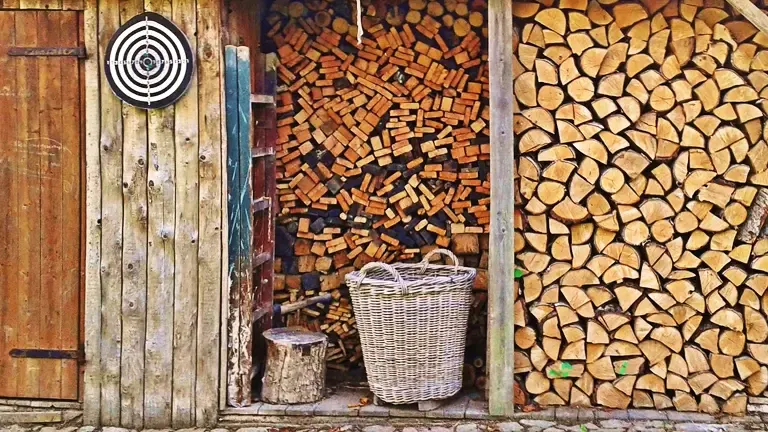
In this enlightening article, we’ll embark on a journey through the art of firewood storage. Highlighting best practices and steering clear of common missteps, we aim to empower you to have fires that glow with warmth and protect the integrity of your wood for years to come. Dive in, and let’s optimize your firewood experience together!
1. Choose the Right Firewood
When it comes to selecting the perfect firewood, there are several key considerations. Your choices can greatly influence the quality of the burn, the heat produced, and even the lifespan of your fireplace or stove.
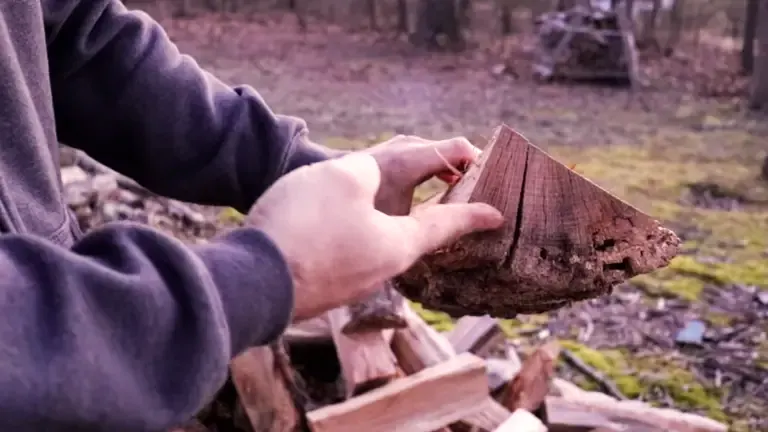
a. Seasoned vs. Green Wood:
What is Seasoned Wood?
Seasoned wood refers to logs that have been dried for a minimum of six months. The drying process is vital as it reduces the moisture content in the wood, making it more suitable for burning. Benefits of seasoned wood include faster ignition and a hotter, more efficient burn. When you’re purchasing wood, always inquire about its seasoning period. If you’re seasoning your own, ensure it’s dried for at least six months for optimal results.

What about Green-Wood?
Greenwood is essentially fresh-cut wood that still retains a high moisture content. Burning green wood can be challenging due to this moisture, leading to excessive smoke and creosote buildup, which can be detrimental to your chimney.
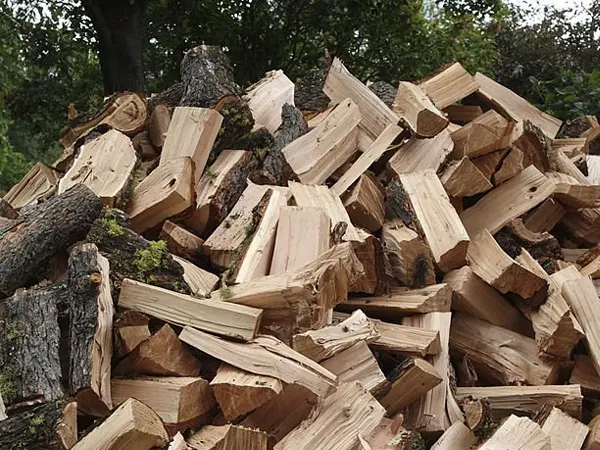
b. Hardwoods vs. Softwoods:
Different tree species have distinct burning characteristics, and understanding these can enhance your firewood experience.

- Hardwoods: Examples of hardwoods include oak, maple, and hickory. These woods are dense, and as a result, they burn for extended periods and release more heat. They’re perfect for those chilly nights when you desire a long-lasting, warm fire.
- Softwoods: Softwoods such as pine and fir have a less dense structure. Their primary advantage is their ability to ignite quickly, making them excellent kindling. However, they also burn at a faster rate, which means they don’t last as long.
Strategic Tip: For an optimal fire, consider using a combination of both hardwoods and softwoods. Start with softwoods to get the fire going swiftly, and then add hardwoods to ensure longevity and consistent warmth.
2. Stacking Your Firewood
Effective stacking of firewood is a delicate blend of choosing the right location, orientation, design, and size. Proper stacking ensures the longevity of the wood, prevents decay, and guarantees safety.
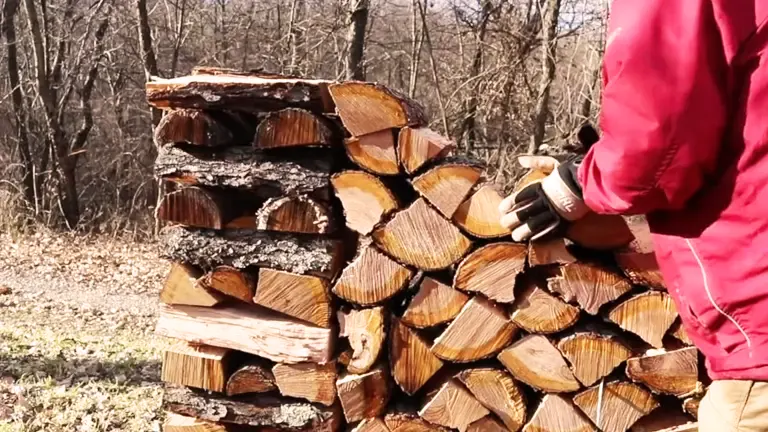
a. Location
- Distance from House: It’s crucial to stack your firewood at a safe distance from your home—typically, a minimum of 30 feet is recommended. This distance discourages pests like termites or rodents, which are often attracted to woodpiles, from making their way into your house.
- Accessibility: While maintaining a distance is essential, don’t place the stack so far that it becomes challenging to access, especially in colder months. Remember, you’ll be fetching wood from this stack, potentially in snowy or icy conditions, so think about convenience and safety.
b. Orientation
Direction Matters
Positioning your woodpile from north to south ensures that the sun’s rays can warm and dry the wood throughout most of the day. This orientation not only promotes effective drying but can also speed up the seasoning process, making the wood even better for burning.
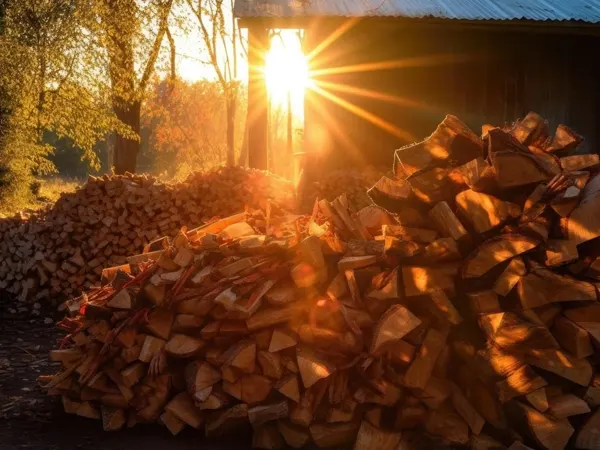
c. Design
Crisscross Stacking
Arranging the logs in a crisscross manner fosters better air circulation around the wood. Improved airflow is vital in reducing moisture, thereby preventing mold growth and enhancing the wood’s burning quality.
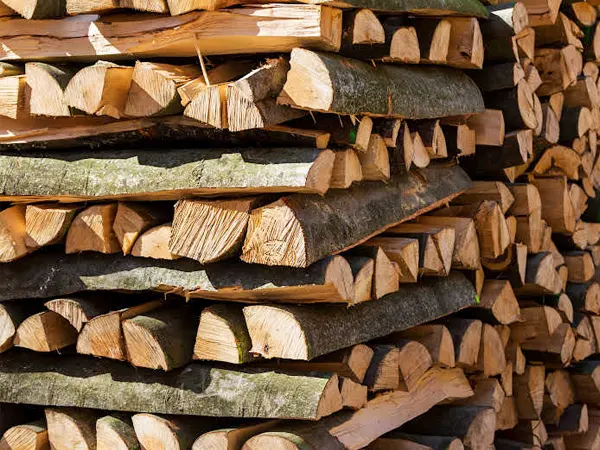
Elevation
One common mistake is stacking wood directly on the ground. Ground moisture can seep into the wood, leading to decay and rendering the wood less efficient for burning. Using pallets, 2x4s, or any elevated platform can keep the wood away from direct contact with the ground, ensuring it remains dry and extends its longevity.
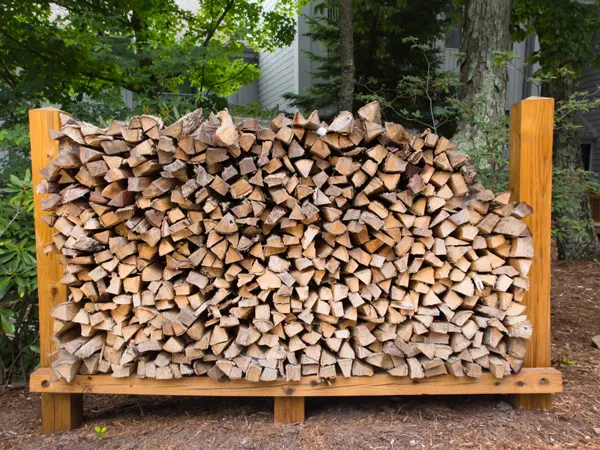
d. Size
Stack Height
While you might be tempted to stack wood very high to save on space, it’s essential to prioritize safety. Keeping your stacks at a manageable height, around 4 feet, minimizes the risk of the pile toppling over and causing potential injury or mess.
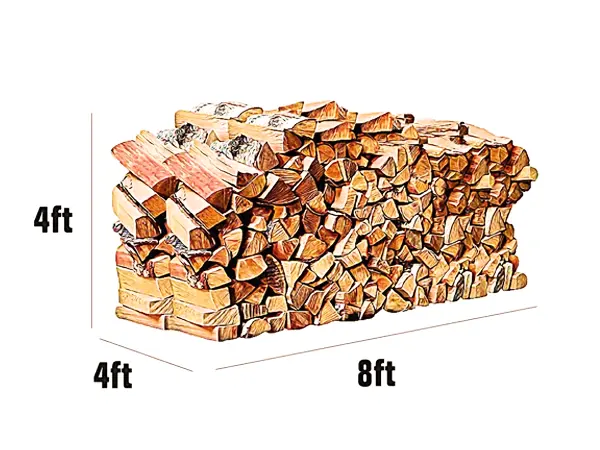
3. Protecting Your Wood
Maintaining the integrity of your firewood is about more than just the initial stacking; it’s about taking proactive measures to ensure that it remains in top condition throughout its storage duration. Proper protection prevents damage, maximizes burn efficiency, and safeguards against unwanted intruders.

a. Covering
- Top-only Coverage: While it might seem intuitive to cover the entire woodpile, doing so can be counterproductive. The goal is to shield the wood from elements like rain and snow while still allowing it to breathe. Hence, only the top of your stack should be covered. This approach ensures the wood remains dry without trapping moisture inside.
- Choice of Material: Utilizing a waterproof material, such as a robust tarp, is advisable. Tarps are both durable and effective against diverse weather conditions, ensuring the wood beneath remains unaffected by precipitation.
- Airflow: Keeping the sides of your stack exposed is crucial for maintaining airflow. Proper circulation helps in evaporating any residual moisture, thereby preventing mold growth and wood degradation.
b. Pest Control
- Routine Inspection: Pests can be quite discreet, making their homes in your woodpile without overt signs until an infestation develops. Regularly checking your stack for indications of termites, carpenter ants, and other wood-loving pests is essential to nip potential problems in the bud.
- Location Strategy: While trees and shrubs provide lovely aesthetics, they can inadvertently become pathways for pests to access your firewood. By ensuring that your stack is distanced from trees and shrubs, you minimize this risk. The vegetation can act as bridges, enabling pests easy access to the stored wood, which can be detrimental both to the wood’s quality and your home’s safety.
4. Using Your Stored Wood
After meticulously storing and protecting your firewood, the final and most satisfying step is using it. However, there are some best practices to ensure that the wood you bring indoors is of the highest quality and ready for a safe burn.
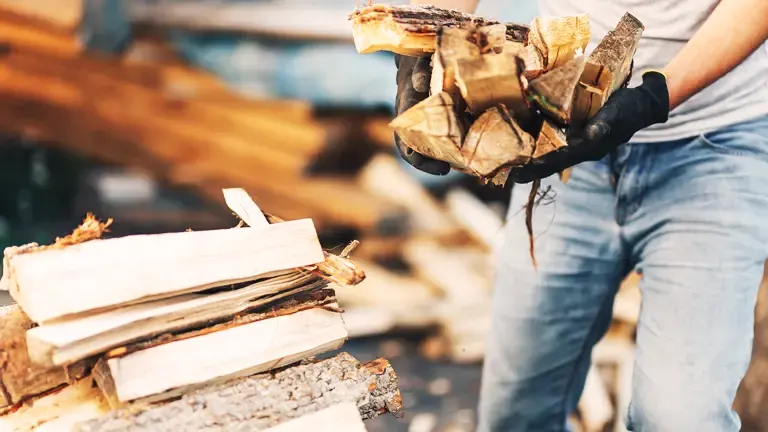
a. Rotation
- First In, First Out: Just like perishables in a pantry, it’s best to use the oldest logs first. This “First In, First Out” method ensures that you’re using the wood that has been seasoned the longest, guaranteeing a more efficient and cleaner burn. Using the oldest logs first also ensures that no wood remains stored for an excessively long time, which could make it more susceptible to decay or pest infestation.
b. Before Bringing Indoors
- Visual and Tactile Inspection: Before transporting any log indoors, give it a thorough once-over. This includes brushing off external elements like snow, ice, or residual moisture. Wet logs can produce excessive smoke, lead to creosote buildup in chimneys, and reduce the efficiency of the burn.
- Pest and Mold Check: Beyond just moisture, it’s essential to check for smaller invaders. Inspect the wood for signs of bugs, pests, or mold. Bugs and mold not only compromise the quality of the burn but could also introduce pests and allergens into your home.
c. Indoor Storage
- Optimal Location: If you prefer having a small stash of firewood indoors for easy access, it’s crucial to store it correctly. Ensure that the area is cool and dry, which aids in preserving the wood’s quality. A damp environment could reintroduce moisture, negating all the effort you took to season and store the wood initially.
- Safety First: While the allure of a firewood stack beside a roaring fireplace might seem picturesque, it’s essential to store the wood away from direct heat sources. This reduces the risk of accidental ignition and ensures a safer environment in your home.
5. Signs of Properly Stored Wood
Properly stored wood ensures a clean, efficient burn and prolongs the lifespan of your fireplace or stove. Recognizing the signs of well-stored wood can enhance your firewood experience. Here’s what to look out for:
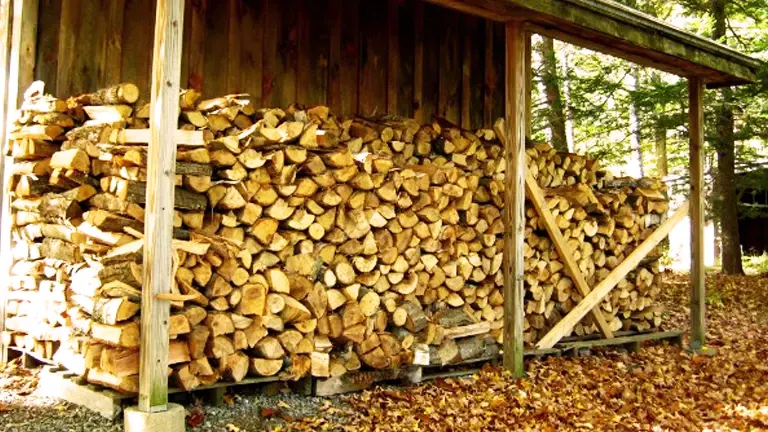
a. Appearance
- Exterior Coloration: Over time, the outer surface of seasoned firewood takes on a darkened or grayish hue. This coloration is indicative of exposure to the elements and the natural seasoning process.
- Interior Contrast: While the external color may be dark, the true test lies within. When split open, the inside of the log should reveal a stark contrast, appearing dry and of a much lighter color. This light, dry appearance is a hallmark of properly seasoned wood.
b. Sound
- The Hollow Ring: One of the simplest tests to determine if your wood is ready for burning is the sound test. When struck against another log, seasoned wood produces a distinctive, hollow clang. This is due to the reduced moisture content within the log.
- The Dull Thud: In contrast, green or unseasoned wood, laden with moisture, emits a dull thud when knocked together. It lacks the crispness of the seasoned wood’s sound, indicating it’s not ideal for burning yet.
c. Feel
- Dry and Lightweight: As wood seasons, it loses its moisture, making it significantly lighter. When you pick up a seasoned log, it should feel dry to the touch and not overly heavy for its size. The absence of moisture gives the wood a noticeably lighter feel compared to freshly cut or green logs.
d. Smell
- The Scent of Maturity: The aroma of wood can also serve as an indicator of its readiness. Seasoned wood tends to emit a mature, woody aroma. This scent is distinct from the sappy or fresh fragrance that one might associate with green wood or freshly cut timber. The absence of a sappy smell indicates that the wood has had ample time to dry and season.
Conclusion
Storing firewood might seem simple, but taking these steps ensures maximum heat output and minimal problems. The ultimate goal is to have a firewood supply that is dry, easily accessible, and free from pests. By following this guide, you’ll enjoy many warm and cozy fires throughout the season.
FAQs
- Why do some people suggest storing firewood with bark facing upwards?
Facing the bark upwards can act as a natural shield against rain or snow, as the bark is a tree’s natural protection against the elements. This orientation can help minimize the direct absorption of moisture into the wood. - Can I store firewood in my basement or garage?
While it might seem convenient, storing large quantities of firewood in basements or garages can introduce pests and mold into your home. If you do, ensure it’s a small quantity and that the wood is well-seasoned and pest-free. - How does the moon phase possibly affect firewood seasoning?
Some old traditions believe that woodcut during specific moon phases burns better and has fewer issues with sap or pests. While there isn’t scientific evidence backing this, it’s a fun folklore to consider! - I’ve heard of a “solar kiln” for firewood. What is it?
A solar kiln is a structure that uses solar energy to speed up the wood-drying process. It’s like a greenhouse for your firewood, harnessing the sun’s power to reduce moisture content more quickly than traditional air-drying methods. - Can the type of wood affect how I should store it?
Generally, storage principles are consistent across wood types. However, certain woods, like pine, have higher sap content and might benefit from more extended seasoning periods or specific orientations to allow the sap to drain. - Are there any tech tools or gadgets to help me store firewood better?
Yes, there are moisture meters available that can measure the moisture content of your firewood. This tool can help you determine if your wood is adequately seasoned and ready for burning. - Why do some wood stacks look like round towers instead of traditional rectangular stacks?
Round or “Holzhausen” stacks are an old European method of stacking firewood. This circular method is both aesthetic and functional, promoting stability and efficient air circulation. - Can I mix green and seasoned wood in my storage?
While you can mix them, it’s essential to keep track of which is which. When burning, you’ll want to prioritize seasoned wood. Mixing might also prolong the seasoning process for the green wood due to reduced airflow. - Does firewood storage affect the flavor of wood when used in smoking or cooking?
Absolutely! Well-stored wood preserves its natural aromas and flavors, which can enhance the taste of foods when used for smoking or wood-fired grilling. - Are there any plants or herbs I can store with my firewood to naturally repel pests?
Some people use herbs like lavender or mint near their wood storage areas, as these plants are believed to deter pests naturally. However, while they might offer a pleasant aroma, their efficacy in repelling pests isn’t scientifically guaranteed.
We’d love to get your feedback! Share your personal experiences and insights about storing firewood in 2025 in the comments section below. Your expertise and tips might just be the game-changer for fellow wood burners seeking the best storage methods!

David Murray
Forestry AuthorI'm David Murry, a forestry equipment specialist with a focus on chainsaw operation. With over 13 years of experience, I've honed my skills in operating and maintaining a wide range of machinery, from chainsaws to log splitters. My passion for the outdoors and commitment to sustainable forestry drive my work, which emphasizes safety, efficiency, and staying updated with industry advancements. Additionally, I'm dedicated to sharing my expertise and promoting environmental awareness within the forestry community.
2 comments
Nice article













Good article Dave. Although you suggest maple as a good hardwood to burn , I find it much like alder , poor heat source and burns rapidly. I prefer fir and somewhat less hemlock. Also fine grained wood is much better and I like to dry up to a year. Being burning wood for over 70 years , also cut wood in the past and as a logger. Cheers
Pete Wilson
September 23, 2023 4:10 pm